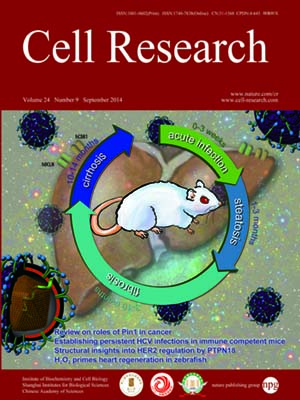
Volume 24, No 9, Sep 2014
ISSN: 1001-0602
EISSN: 1748-7838 2018
impact factor 17.848*
(Clarivate Analytics, 2019)
Volume 24 Issue 9, September 2014: 1137-1140
LETTERS TO THE EDITOR
The IRE1α-XBP1 pathway regulates metabolic stress-induced compensatory proliferation of pancreatic β-cells
Tongfu Xu1,*, Liu Yang2,*, Cheng Yan2, Xiaoxia Wang2, Ping Huang2, Feng Zhao2, Liyun Zhao2,3, Mingliang Zhang4, Weiping Jia4, Xiangdong Wang1 and Yong Liu2,5,6
1Department of Cell Biology, Shandong University School of Medicine, 44 Wenhua Road West, Jinan, Shandong 250012, China
2Key Laboratory of Nutrition and Metabolism, Institute for Nutritional Sciences, Shanghai Institutes for Biological Sciences, Chinese Academy of Sciences, Shanghai 200031, China
3China Novartis Institutes for BioMedical Research, Shanghai 201203, China
4Department of Endocrinology and Metabolism, Shanghai Jiao Tong University Affiliated Sixth People's Hospital, Shanghai 200233, China
5School of Life Science and Technology, ShanghaiTech University, Shanghai 200031, China
6University of the Chinese Academy of Sciences, Shanghai 201203, China
Correspondence: Yong Liu, E-mail: liuy@sibs.ac.cn; Xiangdong Wang,(xdongw@sdu.edu.cn)
In eukaryotes, increased protein folding demand at the endoplasmic reticulum (ER) activates the unfolded protein response (UPR)1, which plays a pivotal role in control of cellular functions and survival under ER stress2. Chronic ER stress is thought to contribute to the pathogenic progression of diabetes3,4. Inositol-requiring enzyme 1 (IRE1), an ER-resident transmembrane Ser/Thr protein kinase and endoribonuclease, is the most conserved ER stress sensor that mediates a key branch of the UPR1. In mammals, activation of IRE1α results in non-conventional splicing of the mRNA encoding the transcription factor X-box binding protein 1 (XBP1), generating a spliced active form of XBP1 (XBP1s) to initiate a major UPR program1. The IRE1-XBP1 pathway has been implicated in the homeostatic regulation of pancreatic islet β-cells. Whereas glucose-stimulated IRE1α activation is coupled to insulin production5,6,7, IRE1α also degrades insulin mRNAs under severe ER stress conditions8. Interestingly, genetic deletion of XBP1 in β-cells of mice was reported to result in a feedback hyperactivation of IRE1α, causing defective proinsulin processing and insulin secretion9. However, the precise role in vivo of IRE1α in integrating metabolic ER stress signals to regulate β-cell functions remains largely elusive.
10.1038/cr.2014.55
FULL TEXT | PDF
Browse 2415


